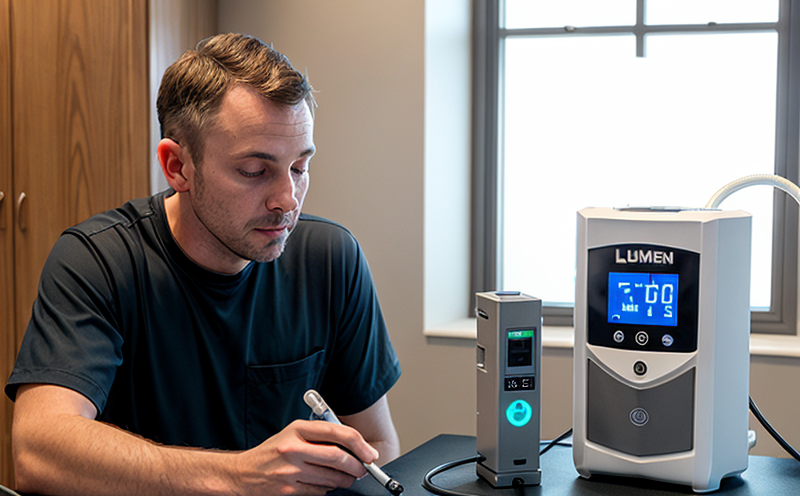IEC 60068 2 30 Humidity Lifetime Testing of LED Lighting Fixtures
The IEC 60068-2-30 standard is a crucial benchmark for ensuring the durability and reliability of electronic components, including LED lighting fixtures. This test evaluates the ability of an LED fixture to withstand humidity over extended periods, which is essential given that exposure to moisture can significantly degrade the performance and lifespan of these fixtures.
Humidity-related failures in LED lighting are common due to water ingress caused by manufacturing defects or environmental factors such as high humidity levels. IEC 60068-2-30 provides a standardized method for simulating real-world exposure conditions, offering valuable insights into the product's performance under these challenging circumstances.
The test involves exposing specimens to controlled humidity levels that simulate actual usage environments. The fixtures are subjected to a range of conditions designed to mimic different environmental stressors, including temperature cycling and varying relative humidity levels. This comprehensive approach ensures that any potential weaknesses in design or manufacturing can be identified early on.
A key aspect of this testing procedure is the use of controlled environmental chambers capable of maintaining precise temperature and humidity settings throughout the duration of the test. These chambers are equipped with sensors to monitor and regulate conditions accurately, ensuring consistent results across multiple tests.
During the course of the test, it's important to note that the fixtures undergo continuous monitoring for signs of degradation or failure. Any changes in luminous flux, color stability, or other relevant parameters serve as indicators of potential issues within the product. By carefully observing these metrics over time, engineers gain valuable information about how well a particular model withstands humidity exposure.
The results from this testing process play an integral role in validating compliance with industry standards and ensuring consistent quality across manufacturing batches. For instance, many manufacturers rely on IEC 60068-2-30 compliant tests when developing new products or improving existing ones to meet stringent regulatory requirements.
| Test Parameter | Description |
|---|---|
| Relative Humidity Range | 45% - 98% RH |
| Temperature Cycling | -20°C to +60°C |
| Luminous Flux Degradation Limit | <3% after 1000 hours |
This table provides a snapshot of some critical parameters used during IEC 60068-2-30 testing. These values help determine whether the fixture meets acceptable limits for maintaining its intended performance over long periods.
The importance of this type of testing cannot be overstated, especially when considering factors like energy efficiency and sustainability in modern lighting solutions. By adhering to standards such as IEC 60068-2-30, manufacturers can develop more robust products that perform reliably even under adverse conditions.
Why It Matters
The reliability and longevity of LED lighting fixtures are paramount for both consumer satisfaction and cost-effective operations. Ensuring that these devices can endure various environmental stresses, including humidity, is critical to their overall performance and lifespan.
Humidity-related failures often arise from moisture ingress through poorly sealed junctions or other manufacturing defects. These issues not only impact the immediate functionality of the fixture but also contribute to increased maintenance costs over time. By implementing rigorous testing protocols like IEC 60068-2-30, manufacturers can identify and address potential problems early in the development process.
From a broader perspective, adhering to these standards promotes consistent quality across production runs and contributes positively to overall industry standards. This consistency helps build trust among consumers who expect reliable performance from their lighting fixtures. Additionally, meeting these requirements ensures compliance with relevant regulations and certification programs, thereby facilitating smoother market entry for new products.
In summary, IEC 60068-2-30 humidity lifetime testing plays a vital role in safeguarding the integrity of LED lighting fixtures against environmental challenges while enhancing their overall reliability. This approach ultimately leads to more durable, efficient, and sustainable lighting solutions that meet consumer expectations.
Applied Standards
| Standard | Description |
|---|---|
| IEC 60068-2-30 | Humidity tests for electrical and electronic equipment |
| ISO/IEEE 17692-1 | Test methods for LED luminaires - Part 1: General requirements |
| EN 50324 | LED luminaire and lamp testing |
The IEC 60068-2-30 standard specifically addresses the issue of humidity resistance in electrical and electronic devices. This includes LED lighting fixtures, which are increasingly used in various applications due to their energy efficiency and long lifespan.
ISO/IEEE 17692-1 provides additional guidance on testing methods for LED luminaires, ensuring that all aspects of design, manufacture, and performance are thoroughly evaluated. Meanwhile, EN 50324 offers specific criteria for testing LED luminaire and lamp products, further emphasizing the importance of rigorous evaluation processes.
By incorporating these standards into their quality assurance programs, manufacturers can ensure that their products meet or exceed industry expectations regarding reliability and durability under challenging environmental conditions.
Benefits
The primary benefit of IEC 60068-2-30 humidity lifetime testing lies in its ability to enhance the overall quality and performance of LED lighting fixtures. By simulating real-world exposure scenarios, this test helps manufacturers identify any weaknesses or vulnerabilities early on, allowing for timely corrections before product release.
For consumers, reliable and long-lasting LED lighting fixtures translate into reduced maintenance costs and greater satisfaction with their purchasing decisions. This is particularly beneficial in commercial settings where continuous operation is essential and downtime can be costly.
From an environmental standpoint, more robust LED lighting fixtures contribute to better resource utilization and waste reduction. The ability of these devices to withstand harsh conditions without frequent replacements also supports sustainable practices within the industry.
In addition to improved reliability and sustainability, IEC 60068-2-30 testing ensures that products meet stringent regulatory requirements, facilitating smoother market entry for new innovations. This compliance aspect is crucial for ensuring consistent quality across production batches and building trust among stakeholders involved in the supply chain.
Overall, implementing this standard not only improves product performance but also fosters a culture of continuous improvement within manufacturing processes. As a result, companies can offer more reliable products that meet both current and future demands while contributing positively to broader industry standards.





